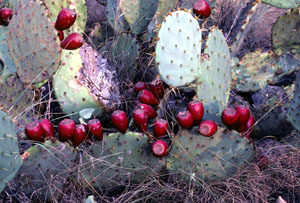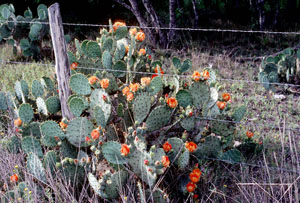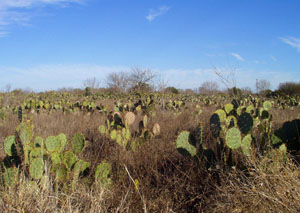Prickly Pear
Oppuntia engelmanni
Cactaceae (Cactus Family)
Prickly pear is a large, spiny cactus that bears numerous deep red, juicy-sweet fruits. Early historic observations and archeological data clearly indicate Native Americans relied on prickly pear for food, medicine, and as a source of needles, containers, and water. Prickly pear gets its name from numerous sharp spines borne on the stems, and the seasonal fruits known as pears or tunas. The long, sharp spines (the prickly part of the name) are actually modified leaves that harden as they age. Technically, the plant’s “branches,” known as pads or nopales, are succulent, evergreen stem segments. The fruit begins to ripen in midsummer to a deep red color and produces a very sweet purple-red juice. The tunas are harvested by many animals as well as people. In southern Texas the most common species of prickly pear is Opuntia engelmannii, which can grow into dense, shrubby clumps covering large tracts of land. In contrast to most types of cactus, prickly pear grows relatively quickly with adequate moisture and spreads easily; broken off stem segments readily take root and create whole plants.
While it is widely known that the pears were the largest part of the diet for several weeks in mid-summer, the plant was used in many other ways. The pads, especially the younger ones, can be eaten year round – direct evidence from Hinds Cave coprolites (dried human feces) suggests that the pads themselves were eaten often. When moist grass or herbs were not available, the pads were used as green packing material providing steamy moisture and chemical compounds that helped bake lechuguilla and sotol. The pads could also be used as containers and even canteens. Prickly pear can also be used for many different medicinal purposes including treating burns, wounds, and diabetes. During the tuna harvest, prickly pear was THE most important food in the region, and ranks with pecans and buffalo as a critical seasonal resource.
Large stands of prickly pear are a signature component in many areas of the South Texas Plains landscape. Students of history have argued over the location of these stands, particularly when trying to locate route of Cabeza de Vaca's journey through Texas. Their job is made difficult by both ancient and modern land use practices, which continually have altered the distribution and density of prickly pear for centuries. We can, however note the presence of dense concentrations west of the Nueces River in Duval and Jim Wells Counties west of the Nueces River, between San Diego and Alice, and southward to the area around Falfurrias (Campbell and Campbell 1981). Another scholar locates the tuna gathering grounds northwest of Beeville and just south of the Nueces River near Freer (Krieger 2002). Johnston (1963) observed that the southern Texas savannahs, a mix of grassy prairies and thorn scrub, were shaped by a combination of fire and local soil types, and that large stands of prickly pear were also present in the clayey soils on the inner coastal plain. Suffice to say that throughout the South Texas Plains there were areas where prickly pear grew in high densities. During the tuna harvest these areas would have been a magnet for seasonal aggregations of native peoples.
Archeological occurrence. Each prickly pear fruit contains about 50 seeds, and it is the hard and durable seed that is found at many archeological sites. However, archeologists have completed very few large-scale excavations in the South Texas Plains, so it is not surprising that they have not found much evidence for prickly pear use. However, a few recent studies using better recovery methods have turned up prickly pear seeds from southern Texas sites. They found prickly pear in two sites from Maverick County and one site from Uvalde County. These three discoveries were made within the past two years, and as archeological activity accelerates, more are sure to follow.
The best preserved examples of prickly pear use are found in the rockshelters of the Lower Pecos, just west of the South Texas Plains. At Hinds Cave, prickly pear seed was present in some deposits at densities exceeding 90 seeds/liter, a strong indication that prickly pear fruit was one of the most common plant foods for the people who lived along the lower Pecos River. We also have more direct evidence that prickly pear was consumed in large quantities by the Hinds Cave inhabitants, because the seeds or fragments of the seeds were found in 74% of the coprolites (desiccated human feces) in one study, and 82% of the coprolites in another study!
The most compelling archeological evidence that nopales were a dietary mainstay come from work at Hinds Cave. Fragments of the epidermis, or the outer skin, of the nopal, were identified in between 8% and 28% of the coprolites in one study, and 70% of the coprolites in another study from Hinds Cave (Stock 1983). Most of the Hinds Cave coprolites are also full of fibers, many of which may well be from nopales, but dietary fibers are so not easy to distinguish. . A wooden mortar and pestle discovered in a cave in northern Val Verde County had prickly pear seeds in the cracks (Collins and Hester 1968). These seeds were probably wedged into the cracks when the user was pounding prickly pear fruits into juice and pulp. The juice is separated and consumed, and the remaining pulp can be sun-dried and stored.
Food. Please heed the following warning. Although they share many positive benefits, there are critical differences between the domesticated prickly pear (Opuntia ficus-indica) and the wild species of prickly pear that most of the Native Americans consumed (Opuntia engelmannii and others). Even the immature pads and ripe fruit of wild prickly pear cactus can have very small spines that cause inflammation of the tongue and throat. These must be removed carefully. It is smarter to buy the spineless, cultivated variety at the grocery store. Nopalitos are available in the fresh fruits and vegetables section of most grocery stores, as are the tunas (fruit). The grocery store nopales and tunas are grown from a spineless prickly pear variety originally developed by the famous plant breeder Luther Burbank.
Some early explorers learned the hard way that wild-type prickly pear tunas have to be processed carefully. The following account describes a historic prickly pear accident that occurred on Matagorda Island, as related by Henri Joutel, a survivor of La Salle’s expedition to Texas in the late 17th century:
One must strip the fruit before eating it because, although the quills are quite small and almost imperceptible, without fail they make one sick once they lodge in the throat and on the roof of the mouth. One of our soldiers even died from having eaten the fig greedily without wiping it. All these quills caused tremendous inflammation of the throat and eventually suffocated him. (Foster 1998) (author's emphasis)
However, if you carefully remove the spines and prickly tufts, both the fruit and pads, especially the young pads (nopalitos) are edible. Although 85-90% water by weight, prickly pear fruit is rich in Vitamin C and is a good source of carbohydrates. The pads contain fewer carbohydrates but are rich in Vitamin A. Prickly pear pads (green fleshy stems) were edible, and even used as containers. Both the immature pads (nopalitos) and the mature pads (nopales) were consumed by the foragers of the past. Although the immature pad can be eaten raw, the mature pad most likely was baked first.
The most famous ethnohistoric account of prickly pear use is the great recorded by Cabeza de Vaca, the first European to cross Texas and write a first-hand report. In midsummer many different groups would converge on the area in southern Texas where prickly pear was ripening, and this was their favorite time of the year.
They would squeeze the juice out of the fruit and dry the pulp and skin (Covey 1983). He also describes how they "gathered many tuna leaves and roasted them in an oven, and we gave them so much fire that [the tuna leaves] were ready to eat (Krieger 2002).
Other accounts from Texas and northern Mexico underscore the importance of prickly pear to the lifeways of the Native Americans living in the region. In the mid 1600s the Apache were pushing south, pressuring other native groups, and the Spanish were attempting to quell general unrest in the region. Native American representatives were requesting that settlements be established for them. In 1673, three representatives, Don Marcos (a Jumano), his brother don Lacaro Agustin (a Jumano) and another Don Marcos (a Babane) requested settlement in a pueblo. Assisting as an interpreter in this request was a Franciscan friar, Fr. Juan Larios. The request was denied but it marked the entry of Fr. Juan Larios into Native American affairs, and during his ensuing travels he made several interesting observations regarding the peoples of the region (Wade 2003).
Eventually, Fr. Larios, with the help of Captain Elizondo and others, founded two settlements in the Rio Grande Plains south of the Rio Grande. Santa Rosa de Santa Maria was located on the Sabinas River. San Ildefonso de la Paz was 14 leagues (36 miles) north of the Sabinas and about 50 miles south of Del Rio, Texas. Santa Rosa on the Sabinas was well situated to attract large groups of Native Americans, as it had an adequate water source, nut-bearing trees, and prickly pear fields. In June of 1674 the Native population at Santa Rosa grew into about 3,200 during the prickly pear harvest, but the friars were concerned that they would disperse when the ripe tuna supply was exhausted. Sure enough, as soon as the harvest ended, the people dispersed. (Wade 2003).
This classic hunting and gathering behavior, in which groups aggregated during the harvest of densely packed resources such as prickly pear tunas or pecans, was always followed by their dispersal. This behavior confounded the Spaniards' plans to control Native American movements and settlements.
The important role of prickly pear fields and harvests also appears in the negotiations between El Turnio, a Lipan Apache, and Captain Rabago, representative of the Spanish government. Rabago agreed to establish a mission for the Lipan, Nuestra Senora de la Candelaria, near the modern town of Montell north of Uvalde. Interestingly, this location is strategically situated in reasonably close proximity to the pecan groves of the upper Nueces, the buffalo hunting grounds of the Edwards Plateau, and the prickly pear fields of the South Texas Plains. El Turnio agreed to live there, but only on the condition that he could leave the settlement when the prickly pear tunas were ripe (Wade 2003). This underscores the importance of the prickly pear to the survival of all the Natives of the region.
Ethnographic accounts of prickly pear that were recorded outside of Texas give us more ideas about the use of this plant. Tunas are harvested by knocking or twisting the fruits off the pads into a basket. The stiff hairs that cover the fruits need to be removed before they are consumed, and this can be accomplished by parching the fruit in hot coals or rubbing off the hairs using a rock. The fruits can be eaten raw, or they can be pounded in a mortar and pestle
Typical preparation of the fruit includes drying and pressing fruits in to a large flatcake, as done by the Yavapai. There are examples of the fruit being pit-baked, as is reported for the Cahuilla. The Cahuilla pick the fleshy young fruit of Opuntia basilaris in early summer and steam or bake it (Bean and Saubel 1972). Opuntia engelmannii fruit is very juicy and needs only to be pounded and sun-dried. Although there are no ethnographic references to pit-baking green or partially ripened Opuntia engelmannii, Phil Dering has pit-baked the green or partially fruit and found it to be palatable.
Medicine and other uses. Prickly pear pads also have very useful medicinal applications, and the dietary value of the immature pads, or nopalitos, may prove to be important in controlling or preventing Type 2 (adult onset) diabetes. Here are some of the historic and modern uses of nopales documented by oral history as well as some actual medical research. Although some of these uses might work for wilderness first aid in extreme situations, please don't try out these techniques at home without the guidance of a medical professional.
- Infusion of pads used to treat urinary tract infections
- Mucilage (pulp) in raw nopalitos reduces rate of sugar absorption, hence they are effectively reduce symptoms of insulin shock
- Mature pads as poultice and antiseptic for wounds
- Mature pads to treat burns
- Tea made from pads for treating tuberculosis scar tissue
- Mucilage from mature pads kills bacteria in cultures, so it has antibiotic properties
- Hot poultice of prickly pear pad skin applied to boils
- Split pads used as a hemostat to stop bleeding
- Infusion of pads used to treat swollen prostate
Pads are high in calcium, both insoluble calcium oxalate and soluble mucilage. They have a hypoglycemic effect, significantly lowering cholesterol and preventing glycemia. Soluble fibers, including viscous mucilage, inhibit the absorption of simple carbohydrates. Pads also contain high levels of amylose, a starch that breaks down into simple sugars more slowly than amylopectin, the starch in bread and potatoes. Mature pads, however, contain calcium oxalate crystals that are insoluble and may cause health problems. According to Laredo herbalist Tony Ramirez, nopales are useful in " preventing diet-related cardiovascular disease and adult onset diabetes" as well as protecting the male prostate gland. (Fowler 2001)
Bean, L., and K. Saubel
1972 Temalpakh: Cahuilla Indian Knowledge and Usage of Plants . Malki Museum Press.
Covey, Cyclone, translator and editor
1983 Adventures in the Unknown Interior of America by Alvar Nunez Cabeza de Vaca. University of New Mexico Press. [reprint of 1961 edition published by Crowell-Collier Publishing].
Campbell, Thomas N., and T.J. Campbell
1981 Historic Indian Groups of the Choke Canyon Reservoir and Surrounding Area. Choke Canyon Series Volume 1. Center for Archeological Research. The University of Texas at San Antonio. San Antonio, Texas.
Collins, Michael B. and Thomas R. Hester
1968 A Wooden Mortar and Pestle From Val Verde County, Texas. Bulletin of the Texas Archeological Society 39:1-8.
Fowler, Gene
2001 Rattler Oil, Mesquite Beans and Prickly Pear: Medicine from Nature's Pharmacy. Texas Co-Op Power, September.
Gutierrez, Miguel A.
1998 Medicinal Use of the Latin Food Staple Nopales: The Prickly Pear Cactus. Nutrition Bytes 4(2) Article 3. http://repositories.cdlib.org/uclabiolchem/
nutritionbytes/vol4/iss2/art3,
accessed August 14, 2006.
Johnston, M. C.
1963 Past and Present Grasslands of Texas and Mexico. Ecology 44(3):456- 466.
Krieger, Alex D.
2002 We Came Naked and Barefoot: The Journey of Cabeza de Vaca across North America. University of Texas Press. Austin.
Stock, Janet A.
1983 The Prehistoric Diet of Hinds Cave. Department of Anthropology, Texas A&M University, College Station.
Wade, Maria
2003 The Native Americans of the Texas Edwards Plateau. University of Texas Press. Austin, Texas.
William C. Foster, ed.
1998 La Salle Expedition to Texas: The Journal of Henri Joutel, 1684-1687. Texas State Historical Association, Austin.


